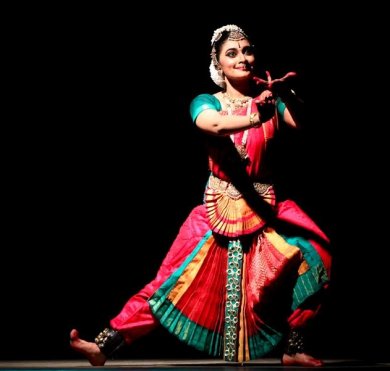 |
 |
Manjari: A beautiful conceptual presentation by Divya Ravi February 4, 2017  Divya Ravi is a senior disciple of Dr. Soundarya Srivathsa, Kiran
Subramanyam and Sandhya Kiran. She held the audience spellbound in her
recital at Bharatiya Vidya Bhavan, Chennai, on 17th January 2017. The
performance was for the Kalapradarshini festival conducted by senior
artiste and guru Parvathi Ravi Ghantasala. The thematic Bharatanatyam
margam about flowers was scripted by Divya along with Dr. Sharan
Subramanian and was choreographed by Divya. A picture of grace and
elegance, Divya opened the alarippu in sankeerna triputa tala
symbolising the blossoming of a flower - how the bud progresses to a
flower by absorbing the energies (Panchabhoothas), and as the bud
blossoms, how each petal seems to pay obeisance to the Ashtadikh. Divya Ravi is a senior disciple of Dr. Soundarya Srivathsa, Kiran
Subramanyam and Sandhya Kiran. She held the audience spellbound in her
recital at Bharatiya Vidya Bhavan, Chennai, on 17th January 2017. The
performance was for the Kalapradarshini festival conducted by senior
artiste and guru Parvathi Ravi Ghantasala. The thematic Bharatanatyam
margam about flowers was scripted by Divya along with Dr. Sharan
Subramanian and was choreographed by Divya. A picture of grace and
elegance, Divya opened the alarippu in sankeerna triputa tala
symbolising the blossoming of a flower - how the bud progresses to a
flower by absorbing the energies (Panchabhoothas), and as the bud
blossoms, how each petal seems to pay obeisance to the Ashtadikh. The varnam in Ragamalika (Hamsanadam, Nasikabhushani, Amritavarshini, Bhageshri, Thodi, Kanada, Bowli, Hindolam and Kamalamanohari) and adi tala depicted the glory of the lotus flower. The various sancharis delineated were – the lotus blossoming as the sun rays touch the bud; Brahma creating the entire universe from the lotus; the similarity between the lotus and human body both of which draw energies from the Panchabhoothas, namely Salila, Vayu, Bhoomi, Gagana and Anala (water, wind, earth, space and fire); the atma being uncontaminated by the impurities of the human vices just like the lotus being unaffected by the impurities of the waters. Then came the concept of the Seven Chakras and how these various energy centres depicted by lotuses are channelised into the human system. Divya’s abhinaya for all these concepts elicited lot of appreciation from the audience. The second half of the varnam described how Subrahmanya, Saraswati, Vishnu and Lakshmi are associated with the flower. Subramanya was born as six babies on six lotuses; Saraswati sits on a white lotus “Sweta Padmadolu Viraja” (what Bharathiyar described as “Vellai thamarai poovil iruppal”); Vishnu as Padmanabha; and Lakshmi, a synonym of the lotus herself. The concept was interspersed with well choreographed jathis, which were delightfully executed by Divya with absolute precision. The padam depicted the story of the cursed Thazhampoo flower where the beginning and the ending of the piece showed a kalahantarita nayika (in a state of repentance). Divya chose to don the role of the Thazhampoo as the nayika, describing the reason behind the flower’s curse. While Lord Vishnu and Lord Brahma were trying to assert their superiority over each other, Shiva appeared in the form of a Jyotirlinga, with instructions to the contenders to find the Adhi and Antha (beginning and end) of the Jyotirlinga. Vishnu took the form of a Varaha and dug down but was unable to find the Antha. Brahma then took the form of a Hamsa and flew upwards but was unable to find the Adhi. However, Brahma saw a Thazhampoo, and together, they hatch a plot trying to befool Vishnu, by claiming that Brahma saw the flower at the top of Shiva’s head, implying that he has seen the Adhi. Enraged, Shiva curses Brahma as well as the flower that there will be no temple for Brahma on earth and that Thazhampoo will never again be used in Shiva’s worship. The protagonist Thazhampoo laments – “Iraivanidam thavaralamo vazhi” and rues her fate. This story was very poignantly portrayed by Divya. The ragas used - Saramatji and Kalyanavasantham - were apt to denote the mood of the padam. The fitting finale well executed by Divya was the thillana showing the three aspects of flower which can be compared to a human – regenerative aspect, ability to spread happiness and absolute surrender. This was in ragam Lathangi in khanda chapu talam. The lyrics were composed by D.S. Srivathsa and the jathis were by Srihari Rangaswamy. The compositions were apt and appealing. The vocal rendition by Srivathsa was an asset. Mridangam by Srihari Rangaswamy, rhythm pads and khanjira by Karthik Dattar, flute by Mahesh Swamy and veena by Shubha Santhosh added colour to the presentation. D.V. Prasanna Kumar wielded the cymbals energetically. The entire orchestral support well complemented Divya’s recital. Divya has already carved a niche for herself as a performing artiste and she will be a delight to watch in the years to come. |